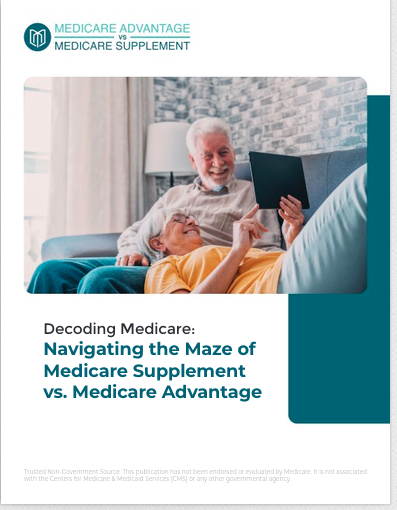Key Takeaways
-
Medicare Advantage and Medicare Supplement plans serve very different purposes. Choosing one over the other directly impacts your provider access, cost-sharing, and coverage stability.
-
In 2025, understanding the fine print on networks, referrals, travel coverage, and coordination with Part D is more important than ever to avoid unexpected expenses.
What You Should Know First
If you’re approaching Medicare eligibility or thinking of changing your coverage this year, there’s a good chance you’re facing the choice between Medicare Advantage and Medicare Supplement (also known as Medigap). Both are designed to help manage your healthcare costs, but they go about it in entirely different ways. And contrary to what many assume, they are not interchangeable.
Medicare Advantage plans are all-in-one alternatives to Original Medicare. They combine Parts A and B and often include Part D drug coverage. Medicare Supplement plans, by contrast, work with Original Medicare to cover the out-of-pocket costs that Parts A and B don’t pay—like deductibles, coinsurance, and copayments.
The differences may sound simple on the surface. But the implications go deep, especially in 2025 when Medicare continues to evolve.
1. You Can’t Have Both
The first and most important thing to understand is that you cannot enroll in both Medicare Advantage and Medicare Supplement. You must choose one route.
If you go with a Medicare Advantage plan, you are leaving Original Medicare. Your benefits are administered by a private insurer approved by Medicare. A Medicare Supplement plan, on the other hand, only works alongside Original Medicare, not instead of it.
This decision shapes how you receive care, how much freedom you have to choose providers, and how much you may pay out-of-pocket.
2. Networks vs. Freedom to Choose
Medicare Advantage plans usually come with a provider network, often based on an HMO (Health Maintenance Organization) or PPO (Preferred Provider Organization) model. If you go out-of-network with an HMO plan, you might have to pay the full cost of care except in emergencies.
With PPOs, you get more flexibility, but staying in-network usually costs less. Referrals to see specialists may also be required.
Medicare Supplement plans don’t rely on networks. You can see any doctor or specialist that accepts Medicare, anywhere in the United States. There are no referrals needed, and you’re not limited by geography or provider lists.
3. Predictability of Costs
Medicare Supplement plans generally offer more predictable costs. You pay a monthly premium for the plan, but your share of healthcare costs—if any—remains relatively steady, especially if you have a plan that covers most deductibles and coinsurance.
Medicare Advantage plans often have lower monthly premiums, but you may face more out-of-pocket costs when you use services. In 2025, the maximum out-of-pocket limit for in-network care is $9,350. For plans that include out-of-network coverage, the combined limit may go as high as $14,000.
If you expect frequent medical visits or need complex care, these costs can add up quickly.
4. Drug Coverage Isn’t Handled the Same Way
Most Medicare Advantage plans include Part D prescription drug coverage automatically. However, Medicare Supplement plans do not. If you choose a Medigap policy, you’ll need to enroll in a standalone Part D plan for your medications.
Failing to do so when first eligible can result in a late enrollment penalty.
5. Emergency Coverage While Traveling
Medicare Advantage plans typically limit you to a local or regional provider network. While emergency care is covered nationwide, routine or non-emergency care outside of your network area may not be covered at all.
Medicare Supplement plans, particularly certain types, can include limited emergency coverage while traveling outside the United States—an option not available with most Advantage plans.
If you travel often, whether domestically or internationally, that should factor heavily into your decision.
6. Enrollment Windows and Underwriting Rules Vary
The timing of your enrollment matters greatly. When you’re first eligible for Medicare at age 65, you have a six-month Medigap Open Enrollment Period. During this time, you can buy any Medicare Supplement plan available in your area without medical underwriting.
Once this window passes, enrolling in or switching Medigap plans may require answering health questions, and coverage can be denied or cost more.
Medicare Advantage plans follow different enrollment timelines. You can join, switch, or drop a Medicare Advantage plan:
-
When you first become eligible for Medicare,
-
During the Annual Enrollment Period from October 15 to December 7,
-
Or during the Medicare Advantage Open Enrollment Period from January 1 to March 31.
7. Coverage Consistency and Future Planning
With Medicare Supplement plans, the coverage doesn’t change from year to year unless you switch plans or carriers. This gives long-term consistency.
Medicare Advantage plans are reevaluated annually. Benefits, premiums, provider networks, and covered medications may change each year. You need to review your Annual Notice of Change each fall to see how your plan is evolving.
This difference matters if you want peace of mind and fewer surprises in retirement.
8. Plan Standardization vs. Plan Variety
Medicare Supplement plans are standardized. This means that a Plan G from one insurer must offer the exact same benefits as a Plan G from another. The only difference is the monthly premium and customer service experience.
Medicare Advantage plans are not standardized. Each plan can offer a different combination of benefits, copays, networks, and extras. This makes comparing plans more complicated and time-consuming.
In 2025, many Advantage plans offer additional benefits such as dental, vision, hearing, and fitness memberships—but these extras vary significantly by plan and location.
9. Medical Underwriting Risks When Switching
If you enroll in a Medicare Advantage plan when you’re first eligible, you might later decide you prefer the flexibility of a Medigap plan. But switching isn’t always easy.
Outside your original Medigap Open Enrollment Period or a guaranteed issue right, switching from Medicare Advantage back to Original Medicare with a Supplement plan could require medical underwriting. If you have health issues, you may be denied coverage or charged more.
This is why many people who value long-term access and predictability choose Medigap from the start and never switch.
10. Coordination with VA, TRICARE, and Employer Plans
If you have benefits through the Department of Veterans Affairs (VA), TRICARE, or an employer-sponsored retiree plan, how those coordinate with Medicare can differ based on your choice.
Medicare Supplement plans typically work more smoothly with VA and TRICARE since they don’t interfere with how you access Original Medicare. Medicare Advantage plans may create conflicts or redundancies in coverage, particularly if you’re trying to access both VA care and network-based Advantage benefits.
You should speak to a licensed agent if you have other coverage, so you don’t unintentionally lose or overlap benefits.
Make Your Decision Work for You
Choosing between Medicare Advantage and Medicare Supplement in 2025 isn’t just about costs. It’s about the kind of healthcare experience you want in retirement. If you value flexibility, predictable costs, and broad provider access, Medicare Supplement might align better with your needs. If you’re comfortable with networks and want added extras, Medicare Advantage may be appealing.
But whichever direction you lean, make sure you understand how the details affect you—not just this year, but for the long term.
If you’re unsure what to do next, get in touch with a licensed agent listed on this website. They can walk you through your options based on your current coverage, prescriptions, lifestyle, and future plans.










